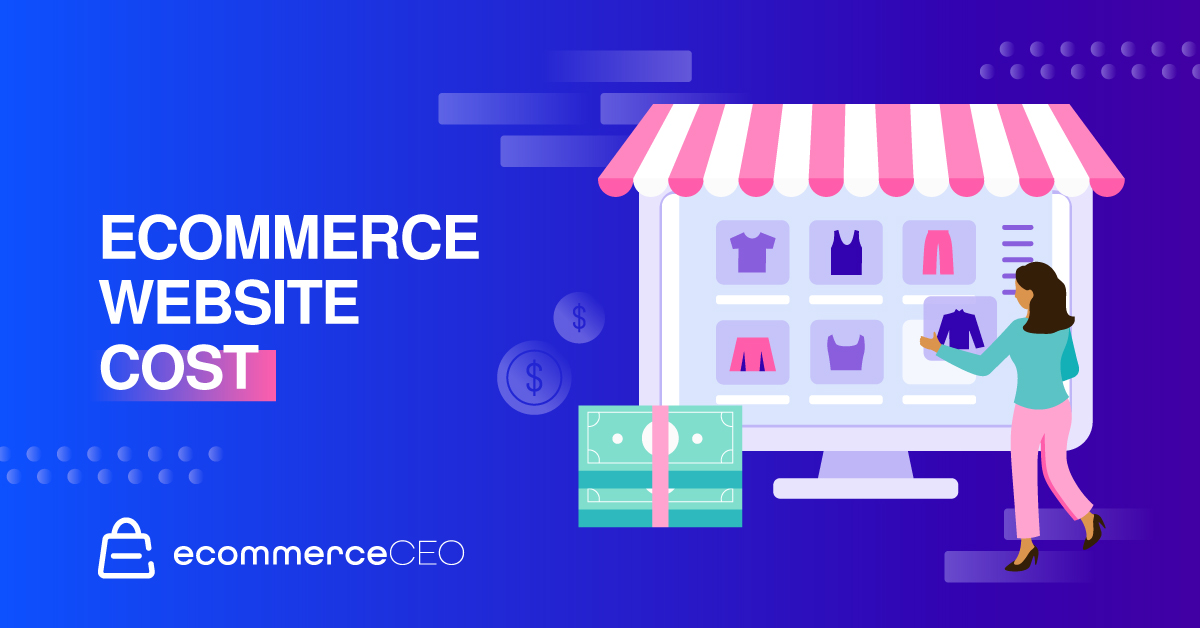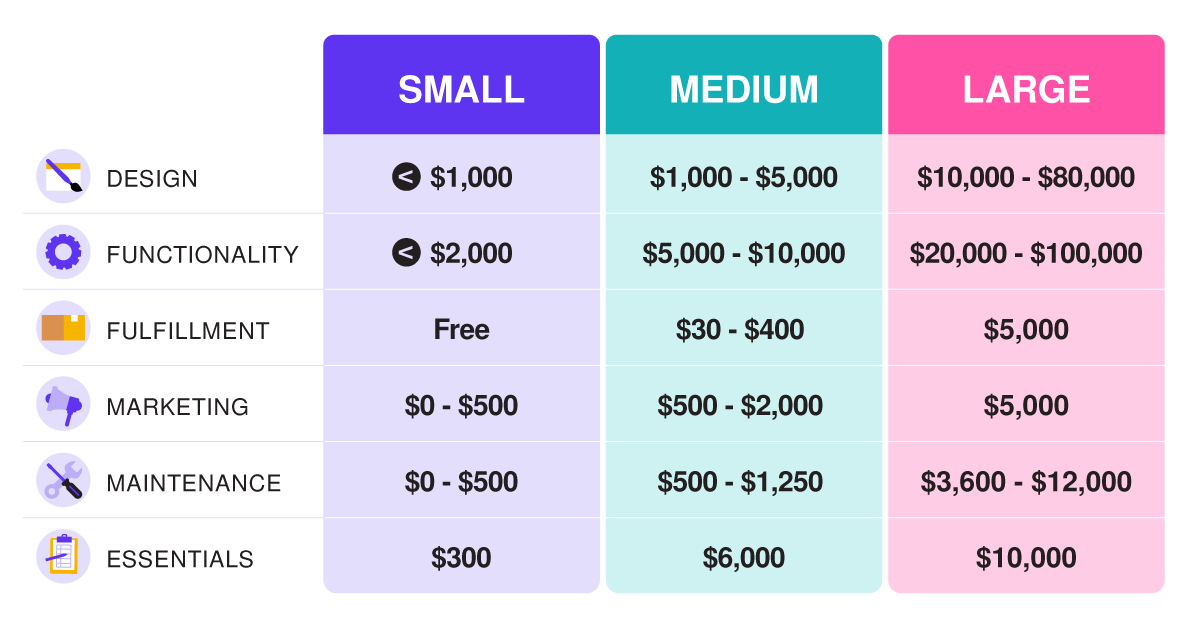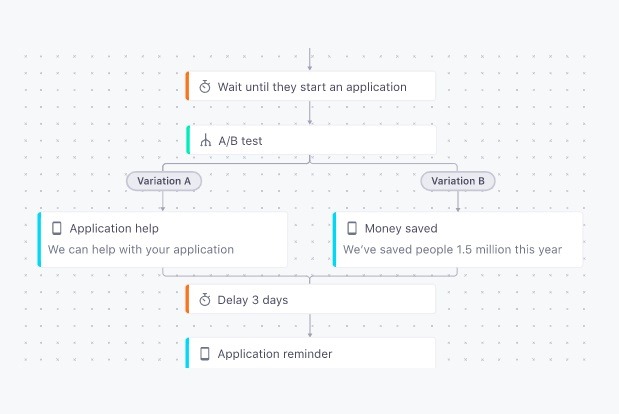If you’re thinking about starting an ecommerce store, you need to build a website – and depending on the scope, you could spend anywhere from a few hundred to thousands of dollars.

Let’s take a closer look at the things that influence ecommerce website cost to give you an idea of the budget you need.
How Much Does an Ecommerce Website Cost?
Unfortunately, there’s no clear-cut answer. Ecommerce website pricing varies widely based on a variety of factors. You’ll get a different answer depending on who you ask.
According to Fit Small Business, you could spend anywhere from $3 to $40,000/month in hosting costs, on top of an initial $100 to $20,000+ in web design setup fees.
Other sources say the average cost to build a website is $12,000 to $150,000 using a freelancer or design agency. Maintenance for the website could be anywhere from $400 to $60,000 per year.
Using a website builder could cost up to $500 a month – but you could spend up to $5,400 per year on maintenance.
You’ll save money on the total cost of an ecommerce site if you use the DIY approach since, on average, website designers charge an average of $75/hour, according to FreshBooks.
Factors that Influence Ecommerce Website Cost

Ecommerce Platform and Web Hosting
With an ecommerce platform, you could pay as little as $20 a month for a basic plan, or $2,500+ for enterprise-level plans. (See Shopify pricing for an idea of what you can expect from one plan to the next.) This fee covers your hosting, SSL certificate security, built-in features, and access to free themes. SaaS ecommerce platforms generally cost less than working with a professional development company on a custom solution, but expenses can still add up. If you need help customizing your Shopify store, for instance, you can hire Shopify developers to help you.
Depending on the premium themes and plugins you’d need to purchase with WordPress and WooCommerce, it may also be more cost-effective than a self-hosted ecommerce website.
If you choose to build your own ecommerce website, you may not have to pay anything for the software that powers it if you use an open-source ecommerce software like WordPress. But, you will still have to pay for a web hosting provider, SSL certificate, and any premium themes or plugins you require.
You can also use free ecommerce website builders, and if you do it yourself, the cost is free. That often means limitations in terms of the number of products you can list, and may not allow you to use a custom domain name.
You can find hosting plans for as little as $2.95/month or as expensive as $1,650/month (or more, depending on the type of hosting).
Managed WordPress plans take care of a lot of the technical aspects for you but will be more expensive. They also limit the amount of traffic you can get every month, so you may have to upgrade.
Depending on the hosting provider you choose, you may not be able to make a month-to-month payment. You should plan on paying for 12 months upfront, though you can reduce the overall cost by committing to 2 or 3 years.
Many hosting solutions offer a free domain name for the first year and a free SSL certificate. However, the free SSL isn’t strong enough to support ecommerce transactions.
Hosting expenses increase significantly when you’re at a large scale and require multiple dedicated servers (you don’t share the hosting space with any other websites) to run your website. And when you reach that point, you should have the revenue to justify the expense.
Ecommerce Software
Ecommerce website pricing is about more than the websites for your online stores. You also have to factor in costs for apps, content, product photography, payment gateway and processing fees, and marketing. Additional software you may need to help you sell online includes:
- Email marketing and automation
- Landing page builder
- Funnel building
- Live chat/help desk
Design Choices
There are a variety of free website themes out there to choose from. Many of them work well for ecommerce businesses but come with fewer customization options out of the box. Because of this, many ecommerce websites use premium themes.
For WordPress, you can get a nice premium theme for under $100. For Shopify themes, you can expect to spend $140 to $180 on paid themes. With BigCommerce, plan to spend $150 to $300.
To keep ecommerce website design costs down, find a template you like, change the colors, and add your logo. Use tools like Crello or Canva to create a logo rather than hiring a professional graphic designer.
Custom Programming and Functionality
You’ll pay more overall if you require any custom ecommerce programming or functionality. Since basic ecommerce functionality is built into most SaaS platforms, you can get by without custom programming.
If you require a lot of advanced features, you may not be able to use services like Shopify and BigCommerce, since they limit access to the source code.
Training and Maintenance
After you deal with the upfront costs of your website, you have to spend money to maintain it. You’ll need to be trained to use it and make basic updates to stock, products, pricing, etc. You’ll risk losing your competitive edge if you can’t handle some maintenance yourself. You may also affect the quality ecommerce experience your customers expect.
Questions to Ask Yourself to Help Determine Website Cost
How soon do you need it to be ready?
Websites take time to build, even if you use a DIY platform. The sooner you need it done, the more you can expect to pay a developer to handle the rush. It can take up to six months to deploy a professionally built website. If you need it faster than that and don’t want to do it yourself, expect to pay a premium.
However, a Shopify website can be up and running within a few hours if you use a premade template and have products ready to go. You’ll still need to spend time on content creation, email marketing, etc., before your online shop is ready to open.
What is the scale of the website?
The more pages your website has, the more it will cost to build, as a general rule.
While software as a service (SaaS) ecommerce platforms, and hosting platforms don’t charge by the page, each page and element on your site takes up storage space. Unless they offer unlimited storage space with your plan, you may need to upgrade to a plan with more space.
When working with professional designers, ecommerce website costs will be based at least in part, on the size of your website. The more pages and elements the design and development team has to work on, the higher the cost will be.
How much traffic do you anticipate?
The more traffic you expect your website to generate, the higher your hosting costs will be. As your volume of sales increases, so will your payment processing costs.
How many products will you be selling?
The more products you sell, the more expensive you can expect the overall site to be. That’s more product pages to create, product descriptions to write, and ultimately makes a larger site to maintain.
What, if any, additional features will you need?
Your ecommerce website development cost will go up based on the number of features you need, and whether those require custom development or not. Custom features are more expensive than plugins that add the feature automatically. You can save some money on the total cost by hiring a developer to customize an existing plugin for you, rather than building something from scratch.
Are you okay with a SaaS platform, or will you need something custom?
If you’re okay building your ecommerce business with a SaaS platform like BigCommerce, Shopify, or Wix, then you won’t spend as much as if you require custom development work.
How much will you focus on the design?
A custom design will be more expensive than a template, and a complex design with many features will cost more than a simple one. The development cost will also vary depending on the size and complexity of the website.
What kind of marketing strategy will you use?
There are a variety of online advertising platforms and strategies to choose from, so it’s important to know which ones will work best for your business. The most common way to market an online store is through search engine optimization (SEO). Optimizing your website for certain keywords and using content marketing techniques can improve your site’s ranking on search engine results pages (SERPs). This will help you attract customers to your store.
You can also use paid advertising with platforms like Google AdWords, Facebook Ads, and Twitter Ads to target potential customers based on their interests and demographics. These platforms allow you to create ad campaigns tailored to your target audience.
SEO is the better way to go on a limited budget since you can write the content yourself. But because it takes longer to produce results, you may need to factor in an advertising budget. If you don’t want the hassle of trying to learn SEO and implement the strategy on your own, you’ll need a budget for that, too.
How many custom pages do you want to be designed and do you want a custom design on mobile?
The more custom pages you need, the more you’ll pay. If you want a mobile responsive design (which you should have since more people use their mobile devices than computers to shop online), you’ll also pay more.
FAQs
Final Thoughts
Ecommerce startup costs vary depending on the industry and whether you’re building the site yourself or hiring someone else to do it for you. No matter what path you choose for your ecommerce project, get cost estimates from multiple ecommerce design companies and compare costs across different ecommerce platforms before you make a decision.







